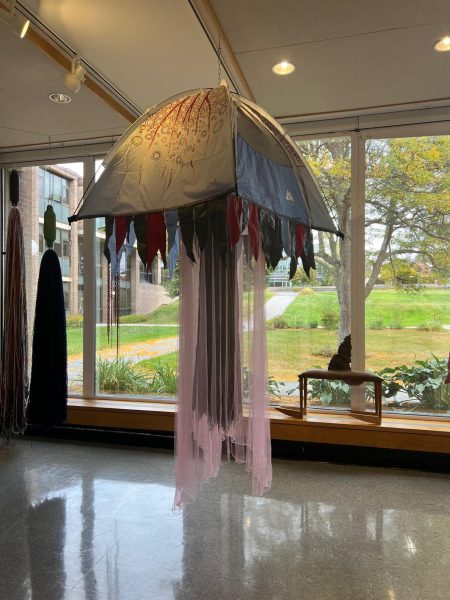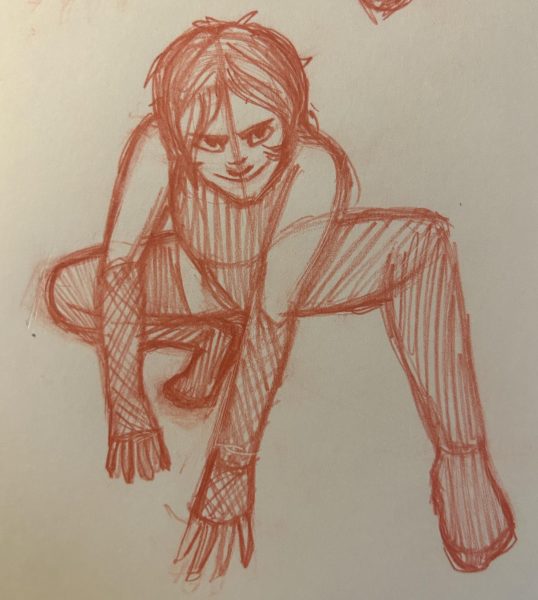Gallery exhibit to donate pencils
Johnson State College Assistant Professor in the Fine Arts Department and Director of the Julian Scott Memorial, Michael Zebrowski held the first art talk of this school year in the Julian Scott Memorial Gallery on Sep. 4.
Zebrowski has teamed up with the office of First-Year Experience at the college to create this exhibit revolving around this year’s Common Book read. This year’s common read is “The Power of a Pencil” by Adam Braun. The book is about Braun’s journey from Wall Street to becoming the founder of Pencils of Promise, a nonprofit organization that builds schools in developing countries for communities that are currently lacking access to education.
This exhibit consisted of three questions for students to respond to on one wall of the gallery. The questions were, what’s the promise of a pencil? Do pencils offer something other than writing implements? What is the value of an education?
Students would then pick up one of the 6,100 pencils from one side of the gallery, sharpen it in the pencil sharpener in the gallery and write on the wall. Once students finished their contribution, they would then place the sharpened pencil on the other side of the gallery, in the areas marked sharpened.
Each one of the 6,100 pencils in the exhibit is supposed to represent 10,000 children lacking access to basic education, the total reflecting the roughly 61 million children.
Planning processes began this past May and continued throughout the summer. “After planning was complete, the exhibit took a few days to install in the Gallery,” said Zebrowski.
Zebrowski worked closely with JSC Coordinators of First-Year Experience Events Emily Neilson and Margo Warden. Since the exhibit’s installation Neilson has a new title at the college as a staff advisor in the Advising and Registration Center.
Sharpen, Write, Erase was one of Neilson’s last coordinated events for her previous position. Neilson and Zebrowski also worked with JSC students Alexandra Ottas, Ashley Slayton, and Martin De Geus to design and install the exhibit.
“We had collaborated on Common Book related art and exhibits in the past,” said Neilson. “I found collaborating on visual exhibits or events to be engaging, dynamic, exciting, and fun.” She explained that having a visual reminder of the Common Book displayed on campus keeps the book fresh in everyone’s minds. “It allows for alternative ways to access the ideas related to the book, and provides an opportunity to interact with the book in a completely different way than reading it.”
“The hope is to get all visitors to engage in the subject matter direction and contribute to an ongoing discussion about education,” says Zebrowski. “It’s also about having a different kind of experience in the gallery, interaction with the gallery.”
Zebrowski described the book as being a prompt to have a bigger discussion on campus about the challenges of education in today’s world, including the ones in our own backyard. “This exhibit is successful in contributing to that ongoing discussion,” he said.
Neilson also feels strongly about the interactive aspect of the exhibit. “Just to interact with the statistic that 61 million children lack access to basic education is staggering,” says Neilson. “For most of us education through high school was a basic right or even a requirement.”
Along with the interactive aspect, Neilson mentioned that the exhibit allows participants to read others thoughts as well and to reply to those thoughts.
One challenge Zebrowski faced focused on the scale of the exhibit. “It was initially proposed to have 61,000 pencils exhibited and donated,” said Zebrowski. “We were unable to procure this amount in time and had to design the exhibit for 6,100 pencils.” Though it was a big design change, Zebrowski says the 6,100 pencils worked very well, leaving him pleased with how the exhibit came together.
Neilson and Zebrowski both consider the exhibit a success. “It was Zebrowski’s idea to make the exhibit interactive in the way it is,” says Neilson. “In one short week after the installation the wall has filled with thoughts, ideas, questions, drawings, etc.”
Neilson mentioned that the overall goal of asking the JSC community to connect the book to broader themes (the value of education, the literal promise of a pencil) seems to be working.
This exhibit will be mounted for the remainder of the semester on the wall opposite the First Year Experience offices. A new area for writing will be defined and the pencil shelves will be put up. “We have a lot more to say and share and a lot more pencils to sharpen,” says Zebrowski. “After the exhibit is complete, JSC is donating all pencils to a local school in need and I like







